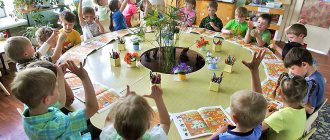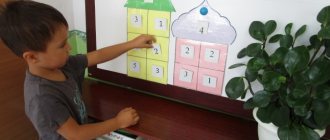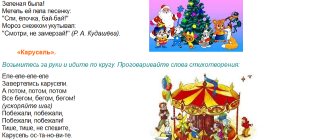Consultation “Didactic materials in the work of a preschool teacher”
Galia
Consultation “Didactic materials in the work of a preschool teacher”
Didactic materials in the work of a preschool teacher
“Leading activity is activity, the implementation of which determines the emergence and formation of the basic mental new formations of a person at a given stage of development of his personality.” [3]
L. S. Vygotsky laid the foundations for ideas about leading activity.
Further, the hypothesis about the leading type of activity was expressed in 1944-45. A. N. Leontiev and was developed in of D. B. Elkonina, V.V. Davydova and others, according to this hypothesis, leading activity is a criterion for the periodization of mental development, an indicator of the child’s psychological age. According to this periodization, the leading activity of preschool children is play.
“Game is the leading type of activity for a preschool child”
.
“Play is an activity in which a child first emotionally and then intellectually masters the entire system of human relationships. A game is a special form of mastering reality by reproducing and modeling it.” In order for the game to educate the child and bring positive emotions during the game, educators select and create special teaching aids . With the help of didactic games, children develop, educate and learn during their natural activities. [4]
To create such a game, didactic materials .
What is the importance of didactic material in kindergarten ?
According to the Federal State Educational Standard for Preschool Education, the developing subject-spatial environment in which children find themselves must, first of all, be content-rich. That is, the educational space must be equipped with means of training and education , appropriate materials ( didactic , including consumable gaming, sports, recreational equipment and inventory. In this context, properly selected didactic materials . They are the teacher’s assistants for the development of the child’s abilities and learning something new.Such materials should be aesthetically attractive, pleasant to the touch, colorful, bright to stimulate interest and attract the child’s attention.
What is didactic material ?
“ Didactic material is a special type of teaching aids, the use of which helps to enhance the cognitive activity of students and save learning time.” [2]
Didactic material , educational material - a type of visual teaching aids (maps, tables, reagents, plants, etc., distributed to students for independent work in class or at home or demonstrated by a teacher; didactic material is also called collections of tasks and exercises.
Didactic materials in preschool institutions are materials that are simple in content and aimed at learning through play, complement it and are used in the process of its implementation (educational games, various cards, drawings, diagrams, presentations)
.
What are didactic materials in the form of a game ? During the game, the child receives a variety of information and learns new skills and knowledge. Play is a part of a child’s life, but through the process of properly selected entertainment, the young explorer will learn. The game brings the child pleasure from the process itself; the result is not important for him. Every game has rules, and the child learns them, remembers them, and thereby learns.
During the game, the child acquires new knowledge and skills.
didactic materials should have : variability of forms and methods of presenting material ; focus on proactive learning; engaging content; focus on developing thinking abilities.
Purposes of using didactic materials :
development of fine motor skills and tactile sensitivity;
formation of ideas about the external properties of objects (shape, color, size, position in space)
;
creating a positive emotional mood;
development of cognitive processes (memory, attention, thinking)
;
development of speech skills;
teaching numeracy and literacy.
All didactic materials are divided into several types:
Subject-shaped manuals reveal the most general, essential characteristics of the objects being studied. Natural (made from natural materials )
and three-dimensional
didactic materials :
Natural visual aids are aids created from natural materials .
Three-dimensional didactic materials are manuals that clearly demonstrate the process or structure of the subject under discussion (models, layouts, dummies, etc.)
.
Iconic didactic materials - designed as material in pictures , handouts , demonstration material (stands, posters, multimedia presentations, etc.)
Figurative-symbolic visual aids are materials that allow children to remember the image of the object being studied as a whole and abstract from particulars (subject and subject pictures, various cards, portraits, applications, photos, films, etc.).
Conventionally symbolic didactic material is material that reveals or examines particulars or details according to one or more active characteristics.
didactic materials for kindergarten yourself. The process of creating manuals includes a number of stages:
Statement of the goal - what exactly the developed didactic material . The benefit must be age-appropriate , understandable and accessible.
Selecting a topic within which teaching material (for example, “Primary colors”
).
Think over the concept of the aid - what type of visual aid is being created: cards, a stand, a poster or an entire game.
Select suitable materials to create a visual aid - the material should be bright so that the child can easily remember what was depicted. The material should not be brittle or easily breakable. The material should be as safe as possible for preschoolers. The materials used must be hypoallergenic. The material must withstand sanitary treatment .
Assembling the material - the information depicted or presented must characterize the world around us and correspond to reality; the didactic material was beautifully and neatly designed.
Timely planning of the use of created didactic material .
The selection of didactic materials depends not only on the material equipment of the preschool educational institution , but also on the set goals of educational work , methods, age of the children, as well as on the characteristic features of individual educational educational institutions.
The use of didactic materials in kindergarten helps to develop the cognitive, communicative and creative abilities of preschoolers of all age groups. When applying benefits, the teacher should remember the wide range of choices for their presentation. Making didactic materials with your own hands allows you to implement various pedagogical ideas in the educational process of a preschool educational institution. The main thing is to correctly develop the manuals , think them through and arrange them. A variety of methodological recommendations and the author’s own imagination will help with this. [9]
Bibliography:
1. Kulikovskaya T. “ Didactic material “The World Around Us”, “Animals of the Arctic and Antarctic”
2. Moiseev V. B. Information technologies in the higher education system. - Penza, 2002. p. 94)
3. Popular psychological encyclopedia. — M.: Eksmo. S. S. Stepanov. 2005. (p. 102)
4. Professional education. Dictionary. Key concepts, term, current vocabulary. - M.: NMC SPO. S. M. Vishnyakova. 1999.
5. Psychological and pedagogical dictionary. / Comp. Rapatsevich E. S. – Minsk, 2006, p. 184-185.
6. The role of didactic materials in the learning process [access mode: https://letopisi.ru/index.php]
7. https://www.montessori-center.ru/kursy-i-seminary_744/didakticheskij-material/
8. https://info-4all.ru/obrazovanie/chto-takoe-didakticheskie-materiali/
9. https://melkie.net/metodicheskie-razrabotki/didakticheskiy-material-dlya-detskogo-sada-svoimi-rukami.html
10. https://psychlib.ru/mgppu/ode/ode-001.htm#$p193
Report for educators on the topic “Didactic materials”
Didactic materials
Children are always willing to do something. This is very useful, and therefore not only should it not be interfered with, but measures must be taken to ensure that they always have something to do.
Komensky Ya.
Little children play always and everywhere. This is the leading activity for preschoolers. Regardless of whether the child goes to kindergarten or not, he gains new knowledge, skills and abilities only through play. To ensure that the game not only pleases, but also educates the child, special manuals are created. Didactic games allow you to develop, educate and teach a child during his natural activities. To create an educational game, special developments are required, including didactic materials.
What is the importance of didactic material in kindergarten?
The space in which children play should not only be comfortable, clean, bright, but also educational. In this, the teacher is supported by correctly selected didactic materials. They are designed to help the teacher develop the child’s abilities and teach something new. Such materials should fit organically into the interior of the group, complementing and expanding the teacher’s capabilities, creating an atmosphere in which the preschooler wants to play and learn new things.
First you need to understand what didactic material is. Moiseev V.B. gives this definition. Didactic material is a special type of teaching aids, the use of which helps to enhance the cognitive activity of students and save learning time.
If we take a psychological-pedagogical dictionary, a didactic (educational) dictionary is a special type of visual teaching aid (mainly maps, tables, sets of cards with text, numbers or pictures, reagents, plants, animals, etc.) distributed to students for independent work. in class or at home or demonstrated by the teacher in front of the whole class. The didactic material, being very simple in its content, design and production technology, can be prepared by the students themselves on behalf of the teacher. Collections of tasks and exercises are also called didactic material.
Didactic materials are auxiliary materials used in the learning process.
Didactics (ancient Greek διδακτικός “teaching”) is a branch of pedagogy and educational theory that studies the problems of teaching. Reveals the patterns of assimilation of knowledge, skills and abilities and the formation of beliefs, determines the volume and structure of the content of education.
Didactic materials include materials that competently complement training: presentations; educational games; all kinds of cards; drawings; diagrams, tables; graphs, diagrams; contour maps. For preschool institutions, these are simpler materials that are aimed at learning through play. At school, these are contour maps, textbooks, workbooks, collections of problems, things that make studying more interesting and effective. Didactic materials help you complete the task independently. Schoolchildren also make such teaching aids with their own hands or together with a teacher. With their help, it is easier to master the lesson and remember new information. Since during the lesson the child not only listens, but also looks at all kinds of examples, drawings, pictures. Training is becoming more diverse. For a more visual understanding of the new material, the teacher can even show an interesting video or presentation. This is also didactic material. Students are interested in this presentation of material.
There are several types of educational didactic materials (tables and graphs): Reference - they contain frequently used information, such tables are usually placed like posters. Educational (such tables serve as additional material to the material being studied, for example, an image of the food chain, a visual image of the seasons). Instructional (such tables are used as samples, for example, for correct spelling). Training (for training and consolidation of the material covered, for example, for training mathematical skills). Information. Images, various pictures, images of objects, animals, cards with pictures or diagrams. For a more visual representation, the drawing can be made in a large format and used as a poster. Each subject has its own educational posters with images.
Electronic manuals
What are educational materials in electronic form? These are video lessons, various presentations, electronic audio and video books. The most effective of all electronic aids are video lessons; by watching such material, most of the information is absorbed. With the help of a video lesson, the student can independently study the topic; this option is convenient if the student is ill or when learning remotely. Such materials are supplemented with tables, diagrams, photographs, which makes the learning process more fun. So, when using electronic materials, there is no need for a whole bunch of paper notes and visual aids, but naturally this does not replace them completely. The presence of electronic materials in the modern world is necessary and plays a huge role in the learning process: the efficiency of mastering the material increases; searching for information takes less time; children are interested in learning the subject; can be used for a large audience; it is possible to clearly explain new information.
Educational games
Let's consider another training option for which various didactic materials are used. These are educational games.
This element of learning is more often used in kindergarten or for younger schoolchildren. What are didactic materials in the form of a game? During the game, the child receives a variety of information and learns new skills and knowledge. Play is a part of a child’s life, but through the process of properly selected entertainment, the young explorer will learn. The game brings the child pleasure from the process itself; the result is not important for him. Every game has rules, and the child learns them, remembers them, and thereby learns. All games can be classified into groups:
Role-playing games. Children act as a director and build the plot of the game themselves. This is great for developing imagination.
Drama games. The child receives new impressions and emotions. They form expressive speech and emotional education.
Games with construction sets, with the help of such simple objects, a child can create any shape; he perceives objects not as toys, but as images of adult objects. During the game, he acquires new knowledge and skills.
What necessary qualities should teaching materials have:
- Variability of forms and methods of supplying material
- Focus on proactive learning
- Interesting content
- Focus on developing thinking abilities
Purposes of using didactic materials
Didactic materials are elements of play and creativity, organically integrated into the child’s activities. Pyramids and towers made of cubes are also a kind of didactic material; you just need to join the child’s play, discussing with him the color, shape and size of the toys. Children develop very quickly, so each year has something different. When selecting or creating didactic material, pay attention to the age characteristics and basic needs of children. At different ages, the same didactic material can be used for different purposes. The purposes of using didactic materials in preschool educational institutions can be the following:
- development of fine motor skills and tactile sensitivity;
- formation of ideas about the external properties of objects (shape, color, size, position in space);
- creating a positive emotional mood;
- development of cognitive processes (memory, attention, thinking);
- development of speech skills;
- teaching numeracy, literacy
The use of a variety of didactic materials in kindergarten classes helps to enhance the cognitive activity of preschoolers.
Main types of didactic material in preschool educational institutions
All didactic materials are divided into several types:
- Subject-shaped aids
The subject material embodies the most general, essential characteristics of the objects being studied. Subject-shaped manuals, in turn, include natural and three-dimensional didactic materials:
- Natural visual aids are aids created from natural materials (for example, herbariums, mineral collections, stuffed animals)
- Three-dimensional didactic materials are manuals that clearly demonstrate the process or structure of the subject under discussion. These materials form a complete and detailed image in the child, allowing him to pay attention to details and features. Volumetric-subject aids include: models, layouts, dummies, etc.
The use of subject-based didactic material in classes at preschool educational institutions arouses keen interest and emotional response from students, increases cognitive motivation, and allows one to combine visual perception with tactile and kinesthetic ones. In addition, preschoolers develop the necessary skills and abilities, and the stability of voluntary attention increases.
- Iconic didactic materials
- Figurative-symbolic visual aids are materials that allow children to remember the image of the object being studied as a whole and abstract from particulars. Such aids include: subject and subject pictures, various cards, portraits, applications, photos, films, etc.
- Conventionally symbolic didactic material is material that reveals or examines particulars or details according to one or more active characteristics.
Iconic didactic material can be designed as: material in pictures, handouts (provides for an individual set for each student), demonstration material (stands, posters, multimedia presentations, etc.).
Do-it-yourself didactic material for kindergarten
It is quite possible to make didactic materials for kindergarten yourself. The process of creating manuals includes a number of stages:
- The first step in creating visual material is to state the purpose. It is necessary to understand what exactly the developed didactic material will give to children, because the manual must correspond to the age of the students, be understandable and accessible.
- The second step is to select the topic within which the didactic material will be created. For example, in order for a child to learn the name of a color and relate it to a specific object (animal, fruit or object), posters or cards are created on the topic “Primary colors”
- Step three is to think over the concept of the benefit. At this stage of creating didactic material, we should decide what type of visual aid we are creating: cards, a stand, a poster, or perhaps an entire game.
- Step four is to select suitable materials to create a visual aid. There are a number of requirements for didactic materials used in preschool educational institutions: The material must be bright so that the child can easily remember what was depicted. The material should not be brittle or easily breakable. Young children feel the need to touch everything that interests them, because through touch they learn about the world. The material should be as safe as possible for preschoolers, even if they stuff it into their mouths (but this is best avoided). The materials used must be hypoallergenic. Preschoolers come to kindergarten with different health indicators, so all items presented for general use must be equally safe for all students. The material must withstand sanitary treatment (for example, cardboard or paper is covered with a special film or tape).
- The fifth step is the direct assembly of the material. When creating a visual aid, you need to remember that the information depicted or presented must characterize the world around you and correspond to reality. It is also important that the didactic material made is beautifully and neatly designed, this creates in the child a sense of beauty and the concept of neatness
- The final step is timely planning of the use of the created teaching material
The selection of didactic materials depends not only on the material equipment of the preschool educational institution, but also on the set goals of educational work, methods, age of the target audience, as well as on the characteristic features of individual educational educational institutions.
Before the advent of the Internet, teaching materials were very difficult to find. Something was “spied” on colleagues, some information was obtained from newspapers and magazines. Someone drew posters and pictures. Audio materials could only be obtained on tape cassettes (not always with good recording quality), and video materials were distributed on video cassettes.
Bibliography:
- Kulikovskaya T. “Didactic material “The World Around Us”, “Animals of the Arctic and Antarctic”
- Moiseev V.B. Information technologies in the higher education system. - Penza, 2002. P. 94)
- Psychological and pedagogical dictionary. / Comp. Rapatsevich E.S. – Minsk, 2006, p. 184-185.
- The role of didactic materials in the learning process [access mode: https://letopisi.ru/index.php]
- https://www.montessori-center.ru/kursy-i-seminary_744/didakticheskij-material/
- https://info-4all.ru/obrazovanie/chto-takoe-didakticheskie-materiali/






